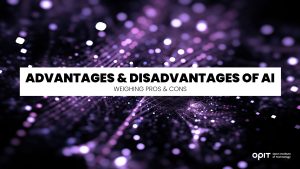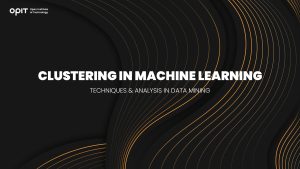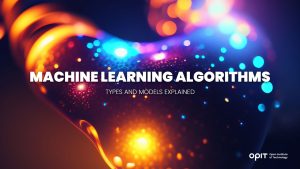
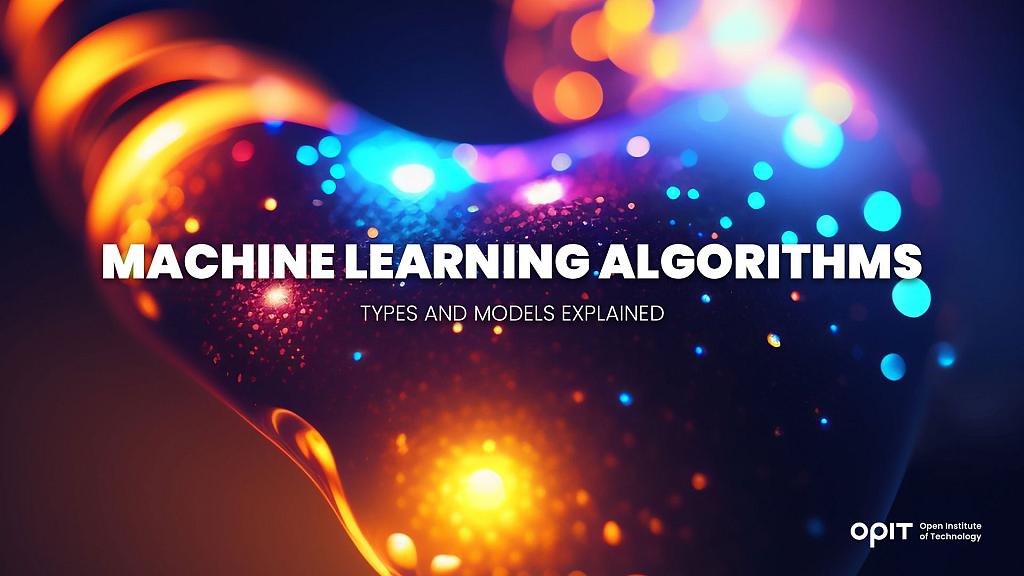
Any tendency or behavior of a consumer in the purchasing process in a certain period is known as customer behavior. For example, the last two years saw an unprecedented rise in online shopping. Such trends must be analyzed, but this is a nightmare for companies that try to take on the task manually. They need a way to speed up the project and make it more accurate.
Enter machine learning algorithms. Machine learning algorithms are methods AI programs use to complete a particular task. In most cases, they predict outcomes based on the provided information.
Without machine learning algorithms, customer behavior analyses would be a shot in the dark. These models are essential because they help enterprises segment their markets, develop new offerings, and perform time-sensitive operations without making wild guesses.
We’ve covered the definition and significance of machine learning, which only scratches the surface of this concept. The following is a detailed overview of the different types, models, and challenges of machine learning algorithms.
Types of Machine Learning Algorithms
A natural way to kick our discussion into motion is to dissect the most common types of machine learning algorithms. Here’s a brief explanation of each model, along with a few real-life examples and applications.
Supervised Learning
You can come across “supervised learning” at every corner of the machine learning realm. But what is it about, and where is it used?
Definition and Examples
Supervised machine learning is like supervised classroom learning. A teacher provides instructions, based on which students perform requested tasks.
In a supervised algorithm, the teacher is replaced by a user who feeds the system with input data. The system draws on this data to make predictions or discover trends, depending on the purpose of the program.
There are many supervised learning algorithms, as illustrated by the following examples:
- Decision trees
- Linear regression
- Gaussian Naïve Bayes
Applications in Various Industries
When supervised machine learning models were invented, it was like discovering the Holy Grail. The technology is incredibly flexible since it permeates a range of industries. For example, supervised algorithms can:
- Detect spam in emails
- Scan biometrics for security enterprises
- Recognize speech for developers of speech synthesis tools
Unsupervised Learning
On the other end of the spectrum of machine learning lies unsupervised learning. You can probably already guess the difference from the previous type, so let’s confirm your assumption.
Definition and Examples
Unsupervised learning is a model that requires no training data. The algorithm performs various tasks intuitively, reducing the need for your input.
Machine learning professionals can tap into many different unsupervised algorithms:
- K-means clustering
- Hierarchical clustering
- Gaussian Mixture Models
Applications in Various Industries
Unsupervised learning models are widespread across a range of industries. Like supervised solutions, they can accomplish virtually anything:
- Segment target audiences for marketing firms
- Grouping DNA characteristics for biology research organizations
- Detecting anomalies and fraud for banks and other financial enterprises
Reinforcement Learning
How many times have your teachers rewarded you for a job well done? By doing so, they reinforced your learning and encouraged you to keep going.
That’s precisely how reinforcement learning works.
Definition and Examples
Reinforcement learning is a model where an algorithm learns through experimentation. If its action yields a positive outcome, it receives an award and aims to repeat the action. Acts that result in negative outcomes are ignored.
If you want to spearhead the development of a reinforcement learning-based app, you can choose from the following algorithms:
- Markov Decision Process
- Bellman Equations
- Dynamic programming
Applications in Various Industries
Reinforcement learning goes hand in hand with a large number of industries. Take a look at the most common applications:
- Ad optimization for marketing businesses
- Image processing for graphic design
- Traffic control for government bodies
Deep Learning
When talking about machine learning algorithms, you also need to go through deep learning.
Definition and Examples
Surprising as it may sound, deep learning operates similarly to your brain. It’s comprised of at least three layers of linked nodes that carry out different operations. The idea of linked nodes may remind you of something. That’s right – your brain cells.
You can find numerous deep learning models out there, including these:
- Recurrent neural networks
- Deep belief networks
- Multilayer perceptrons
Applications in Various Industries
If you’re looking for a flexible algorithm, look no further than deep learning models. Their ability to help businesses take off is second-to-none:
- Creating 3D characters in video gaming and movie industries
- Visual recognition in telecommunications
- CT scans in healthcare
Popular Machine Learning Algorithms
Our guide has already listed some of the most popular machine-learning algorithms. However, don’t think that’s the end of the story. There are many other algorithms you should keep in mind if you want to gain a better understanding of this technology.
Linear Regression
Linear regression is a form of supervised learning. It’s a simple yet highly effective algorithm that can help polish any business operation in a heartbeat.
Definition and Examples
Linear regression aims to predict a value based on provided input. The trajectory of the prediction path is linear, meaning it has no interruptions. The two main types of this algorithm are:
- Simple linear regression
- Multiple linear regression
Applications in Various Industries
Machine learning algorithms have proved to be a real cash cow for many industries. That especially holds for linear regression models:
- Stock analysis for financial firms
- Anticipating sports outcomes
- Exploring the relationships of different elements to lower pollution
Logistic Regression
Next comes logistic regression. This is another type of supervised learning and is fairly easy to grasp.
Definition and Examples
Logistic regression models are also geared toward predicting certain outcomes. Two classes are at play here: a positive class and a negative class. If the model arrives at the positive class, it logically excludes the negative option, and vice versa.
A great thing about logistic regression algorithms is that they don’t restrict you to just one method of analysis – you get three of these:
- Binary
- Multinomial
- Ordinal
Applications in Various Industries
Logistic regression is a staple of many organizations’ efforts to ramp up their operations and strike a chord with their target audience:
- Providing reliable credit scores for banks
- Identifying diseases using genes
- Optimizing booking practices for hotels
Decision Trees
You need only look out the window at a tree in your backyard to understand decision trees. The principle is straightforward, but the possibilities are endless.
Definition and Examples
A decision tree consists of internal nodes, branches, and leaf nodes. Internal nodes specify the feature or outcome you want to test, whereas branches tell you whether the outcome is possible. Leaf nodes are the so-called end outcome in this system.
The four most common decision tree algorithms are:
- Reduction in variance
- Chi-Square
- ID3
- Cart
Applications in Various Industries
Many companies are in the gutter and on the verge of bankruptcy because they failed to raise their services to the expected standards. However, their luck may turn around if they apply decision trees for different purposes:
- Improving logistics to reach desired goals
- Finding clients by analyzing demographics
- Evaluating growth opportunities
Support Vector Machines
What if you’re looking for an alternative to decision trees? Support vector machines might be an excellent choice.
Definition and Examples
Support vector machines separate your data with surgically accurate lines. These lines divide the information into points close to and far away from the desired values. Based on their proximity to the lines, you can determine the outliers or desired outcomes.
There are as many support vector machines as there are specks of sand on Copacabana Beach (not quite, but the number is still considerable):
- Anova kernel
- RBF kernel
- Linear support vector machines
- Non-linear support vector machines
- Sigmoid kernel
Applications in Various Industries
Here’s what you can do with support vector machines in the business world:
- Recognize handwriting
- Classify images
- Categorize text
Neural Networks
The above deep learning discussion lets you segue into neural networks effortlessly.
Definition and Examples
Neural networks are groups of interconnected nodes that analyze training data previously provided by the user. Here are a few of the most popular neural networks:
- Perceptrons
- Convolutional neural networks
- Multilayer perceptrons
- Recurrent neural networks
Applications in Various Industries
Is your imagination running wild? That’s good news if you master neural networks. You’ll be able to utilize them in countless ways:
- Voice recognition
- CT scans
- Commanding unmanned vehicles
- Social media monitoring
K-means Clustering
The name “K-means” clustering may sound daunting, but no worries – we’ll break down the components of this algorithm into bite-sized pieces.
Definition and Examples
K-means clustering is an algorithm that categorizes data into a K-number of clusters. The information that ends up in the same cluster is considered related. Anything that falls beyond the limit of a cluster is considered an outlier.
These are the most widely used K-means clustering algorithms:
- Hierarchical clustering
- Centroid-based clustering
- Density-based clustering
- Distribution-based clustering
Applications in Various Industries
A bunch of industries can benefit from K-means clustering algorithms:
- Finding optimal transportation routes
- Analyzing calls
- Preventing fraud
- Criminal profiling
Principal Component Analysis
Some algorithms start from certain building blocks. These building blocks are sometimes referred to as principal components. Enter principal component analysis.
Definition and Examples
Principal component analysis is a great way to lower the number of features in your data set. Think of it like downsizing – you reduce the number of individual elements you need to manage to streamline overall management.
The domain of principal component analysis is broad, encompassing many types of this algorithm:
- Sparse analysis
- Logistic analysis
- Robust analysis
- Zero-inflated dimensionality reduction
Applications in Various Industries
Principal component analysis seems useful, but what exactly can you do with it? Here are a few implementations:
- Finding patterns in healthcare records
- Resizing images
- Forecasting ROI
Challenges and Limitations of Machine Learning Algorithms
No computer science field comes without drawbacks. Machine learning algorithms also have their fair share of shortcomings:
- Overfitting and underfitting – Overfitted applications fail to generalize training data properly, whereas under-fitted algorithms can’t map the link between training data and desired outcomes.
- Bias and variance – Bias causes an algorithm to oversimplify data, whereas variance makes it memorize training information and fail to learn from it.
- Data quality and quantity – Poor quality, too much, or too little data can render an algorithm useless.
- Computational complexity – Some computers may not have what it takes to run complex algorithms.
- Ethical considerations – Sourcing training data inevitably triggers privacy and ethical concerns.
Future Trends in Machine Learning Algorithms
If we had a crystal ball, it might say that future of machine learning algorithms looks like this:
- Integration with other technologies – Machine learning may be harmonized with other technologies to propel space missions and other hi-tech achievements.
- Development of new algorithms and techniques – As the amount of data grows, expect more algorithms to spring up.
- Increasing adoption in various industries – Witnessing the efficacy of machine learning in various industries should encourage all other industries to follow in their footsteps.
- Addressing ethical and social concerns – Machine learning developers may find a way to source information safely without jeopardizing someone’s privacy.
Machine Learning Can Expand Your Horizons
Machine learning algorithms have saved the day for many enterprises. By polishing customer segmentation, strategic decision-making, and security, they’ve allowed countless businesses to thrive.
With more machine learning breakthroughs in the offing, expect the impact of this technology to magnify. So, hit the books and learn more about the subject to prepare for new advancements.
Related posts

Source:
- Times of Malta, published on September 18th, 2025
4 min read
The gathering brought together academics and technology leaders from prominent European Institutions, such as Instituto de Empresa (IE University), OPIT itself and the Royal College of Arts, to explore how artificial intelligence is reshaping the university experience.
The OPIT AI Copilot has been trained on the institute’s complete academic archive, a collection created over the past three years that includes 131 courses, more than 3,500 hours of recorded lectures, 7,500 study resources, 320 certified assessments, and thousands of exercises and original learning documents.
Unlike generic AI tools, the Copilot is deeply integrated with OPIT’s learning management system, allowing it to track each student’s progress and provide tailored support.
This integration means the assistant can reference relevant sources within the learning environment, adapt to the student’s stage of study, and ensure that unreleased course content remains inaccessible.
A mobile app is also scheduled for release this autumn, that will allow students to download exercise and access other tools.
During examinations, the Copilot automatically switches to what the institute calls an “anti-cheating mode”, restricting itself to general research support rather than providing direct answers.
For OPIT’s international community of 500 students from nearly 100 countries, many of whom balance studies with full-time work, the ability to access personalised assistance at any time of day is a key advantage.
“Eighty-five per cent of students are already using large language models in some way to study,” said OPIT founder and director Riccardo Ocleppo. “We wanted to go further by creating a solution tailored to our own community, reflecting the real experiences of remote learners and working professionals.”
Tool aims to cut correction time by 30%
The Copilot will also reduce administrative burdens for faculty. It can help grade assignments, generate new educational materials, and create rubrics that allow teachers to cut correction time by as much as 30 per cent.
According to OPIT, this will free up staff to dedicate more time to teaching and direct student engagement.
At the Milan event, Rector Francesco Profumo underlined the broader implications of AI in higher education. “We are in the midst of a deep transformation, where AI is no longer just a tool: it is an environment that radically changes how we learn, teach, and create,” he said.
“But it is not a shortcut. It is a cultural, ethical, and pedagogical challenge, and to meet it we must have the courage to rethink traditional models and build bridges between human and artificial intelligence.”
OPIT was joined on stage by representatives from other leading institutions, including Danielle Barrios O’Neill of the Royal College of Art, who spoke about the role of AI in art and creativity, and Francisco Machin of IE University, who discussed applications in business and management education.
OPIT student Asya Mantovani, also employed at a leading technology and consulting firm in Italy, gave a first-hand account of balancing professional life with online study.
The assistant has been in development for the past eight months, involving a team of OPIT professors, researchers, and engineers.
Ocleppo stressed that OPIT intends to make its AI innovations available beyond its own institution. “We want to put technology at the service of higher education,” he said.
“Our goal is to develop solutions not only for our own students, but also to share with global institutions eager to innovate the learning experience in a future that is approaching very quickly.”
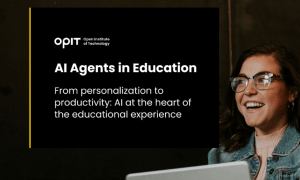
From personalization to productivity: AI at the heart of the educational experience.
Click this link to read and download the e-book.
At its core, teaching is a simple endeavour. The experienced and learned pass on their knowledge and wisdom to new generations. Nothing has changed in that regard. What has changed is how new technologies emerge to facilitate that passing on of knowledge. The printing press, computers, the internet – all have transformed how educators teach and how students learn.
Artificial intelligence (AI) is the next game-changer in the educational space.
Specifically, AI agents have emerged as tools that utilize all of AI’s core strengths, such as data gathering and analysis, pattern identification, and information condensing. Those strengths have been refined, first into simple chatbots capable of providing answers, and now into agents capable of adapting how they learn and adjusting to the environment in which they’re placed. This adaptability, in particular, makes AI agents vital in the educational realm.
The reasons why are simple. AI agents can collect, analyse, and condense massive amounts of educational material across multiple subject areas. More importantly, they can deliver that information to students while observing how the students engage with the material presented. Those observations open the door for tweaks. An AI agent learns alongside their student. Only, the agent’s learning focuses on how it can adapt its delivery to account for a student’s strengths, weaknesses, interests, and existing knowledge.
Think of an AI agent like having a tutor – one who eschews set lesson plans in favour of an adaptive approach designed and tweaked constantly for each specific student.
In this eBook, the Open Institute of Technology (OPIT) will take you on a journey through the world of AI agents as they pertain to education. You will learn what these agents are, how they work, and what they’re capable of achieving in the educational sector. We also explore best practices and key approaches, focusing on how educators can use AI agents to the benefit of their students. Finally, we will discuss other AI tools that both complement and enhance an AI agent’s capabilities, ensuring you deliver the best possible educational experience to your students.
Have questions?
Visit our FAQ page or get in touch with us!
Write us at +39 335 576 0263
Get in touch at hello@opit.com
Talk to one of our Study Advisors
We are international
We can speak in:

